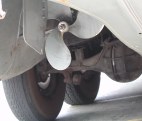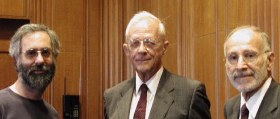danbricklin.com/log
|
||
|
|
Starting July 10, 2001
The Big Five-Oh, Touring Boston on a Duck, Innovation tour and Jay Forrester, War story about scaling a system
10-16Jul01
2001_07_10.htm
|
|
Monday, July 16, 2001
The Big Five-Oh
I turned 50 years old today. Much to be thankful for, especially the fact that the family and friends I love all care and I care that they care, and that many people I don't know also care because I made a difference in their lives. And, I get to tell people about it using tools I helped design.
  Birthday cake: From a family reunion which included my cousin (also 50 - see July 4th), full complement of candles
Thursday, July 12, 2001
Touring Boston on a Duck, Innovation tour and Jay Forrester
Yesterday I went on a tour of Boston with some visiting relatives. We went with the Boston Duck Tours which drives and floats around Boston in renovated World War II amphibious vehicles. It was fun, though you don't get to get as close to history as you do on a walking tour, like the Freedom Trail. Here are some pictures:
   Back of the vehicle, driving down the ramp and splashing into the Charles River (which we were told was named after a Prince Charles by himself), a floating tour
  Small sign on the dashboard, view from my seat while going up the river
Coincidentally, I attended a meeting this morning of the honorary board of the Boston Innovation Odyssey. This is a project of the Boston History Collaborative that has an Innovation Trail tour. A bus takes you to the Massachusetts General Hospital Ether Dome where the world's first modern surgery with modern anesthesia occurred, to the place where Alexander Graham Bell invented the telephone, etc. An actor plays the role of various people (e.g., Bell's assistant Watson) while acting as the tour guide. (They even mention VisiCalc as they drive by the Harvard Business School, which is my connection and why they invited me to attend.)
We listened as an actor showed us some of the skits he performs, heard comments from some of the people active in establishing the tour, and then got a chance to make lots of comments. I sat next to Bill Warner (founder and president of FutureBoston, whose web site is made using Trellix's original product, and founder of Avid Technology and Wildfire Communications). After the meeting, I spent some time talking to Clark Abt and Jay Forrester. Clark is founder and chairman of Abt Associates, a consulting and research firm that "...has achieved an international reputation for using research-based approaches to help solve social and business problems and guide policy decisions." (I visited Mitch Kapor's then-young Lotus Development Corporation in rented space on their campus when Mitch showed me the soon-to-be-announced 1-2-3 many years ago.) The three of us and others talked about education, interesting experiments that teach, the trail, Clark's hybrid car, and more. I took pictures, of course, and had my picture taken.
  Actor Frank Ridley teaching about the invention of the mutual fund, Dan with Jay Forrester and Clark Abt
Jay Forrester is a living legend in the computer industry. While Director of the MIT Digital Computer Laboratory from 1946 to 1951, he was responsible for the design and construction of Whirlwind I, one of the first high-speed digital computers. (More about Whirlwind: pictures, words). That project had an enormous influence on the computer and PC industry. Built to control aircraft flight simulators, it had much higher reliability requirements than the machines before that mainly did calculations that needn't be real-time. (And it had to be reliable even though it was built with vacuum tubes -- transistors were just being invented and integrated circuits were a decade away.) It was the first computer to use the random-access magnetic core memory he invented (for decades later, core memory ruled until semiconductor memory became viable -- we still talk of "core dumps"). People who worked for him on the project, including Ken Olsen (who founded DEC) and Fernando Corbato ("the father of timesharing" who led the Multics project whose spinoff was Unix, and who hired me to work on the project where I met Bob Frankston...) among others, went on to build much of what we now have as a computer industry.
Jay is now working in the field of system dynamics at MIT and is very interested in education. His web page has some interesting papers. Here is some of what he says in one of them about System Dynamics:
System dynamics uses concepts drawn from the field of feedback control to organize available information into computer simulation models...The feedback structure of an organization can dominate decision making far beyond the realization of people in that system. By a feedback structure, I mean a setting where existing conditions lead to decisions that cause changes in the surrounding conditions, that influence later decisions.
We do not live in a unidirectional world in which a problem leads to an action that leads to a solution...Instead, we live in an on-going circular environment...in which each action is based on current conditions, such actions affect conditions, and the changed conditions become the basis for future action. There is no beginning or end to the process. People are interconnected. Many such loops are intertwined. Through long cascaded chains of action, each person is continually reacting to the echo of that person's past actions as well as to the past actions of others...
...A fundamental difference exists between an enterprise operator and an enterprise designer. To illustrate, consider the two most important people in the successful operation of an airplane. One is the airplane designer and the other is the airplane pilot. The designer creates an airplane that the ordinary pilot can fly successfully. Is not the usual manager more a pilot than a designer? A manager is appointed to run an organization. Often there is no one who consciously and intentionally fills the role of organizational designer...
...the digital computer, for the first time allows efficient simulation of complex dynamic models. Such simulation is the only known way to determine behavior in complicated nonlinear systems. Bringing these three innovations [(case method, understanding feedback systems, computers)] together offers the potential for a major breakthrough in management education.
Effectiveness of a model depends on how it uses the wide range of information arising from the system being represented... In creating a system dynamics model, information is used in a substantially different way from that in other branches of the social sciences. The differences arise from the system dynamics focus on policy statements as the basic building blocks of a model and from a broader range of information sources used for creating a model. Information is available from many sources. [For example] three classifications of information [could be] the mental data base, the written data base, and the numerical data base. Although "data" is a term that is often used to mean only numerical information, the dictionary meaning is far broader...
Human affairs are conducted primarily from the mental data base. Anyone who doubts the dominance of remembered information should imagine what would happen to an industrial society if it were deprived of all knowledge in people's heads and if action could be guided only by written policies and numerical information...The mental data base contains vastly more information than the written data base, which, in turn, contains far more information than the numerical data base...
-Jay Forrester
Cool stuff! I like how he first helped invent the tool (a reliable computer to do simulation) that he could then use in a later part of life.
Tuesday, July 10, 2001
War story about scaling a system
In my report about the InfoWorld CTO Forum, I write about a panel I really liked Thursday morning in which some CTOs went through case histories of dealing with problems (the panel was called "Managing in a Crisis"). To someone who identifies with the issues and problems, these are exciting, like listening to "war stories" from veterans (though usually without the issue of real life and death, except in cases like the one Dawn Meyerriecks of the Defense Information Agency related).
I find that I've been repeatedly using one particular "war story" that is very instructive about scaling a web-based application. It is the story of AmIHotOrNot.com, a very successful (in terms of visitors) web site. If you've been involved in systems and look closely at their implementation (which I did for a talk in February), you can guess what problems they were dealing with. To my delight, a first-hand account by one of the people involved came out in May. I was reminded in going over my email how much I've been recommending it to people who haven't seen it, and how much they liked it, so I'll repeat it here:
Read From Hot Concept to Hot Site in Eight Days by James Hong in Web Techniques. (You can see his picture on their site and vote for him...)
|
||
|
© Copyright 1999-2018 by Daniel Bricklin
All Rights Reserved.
|
||